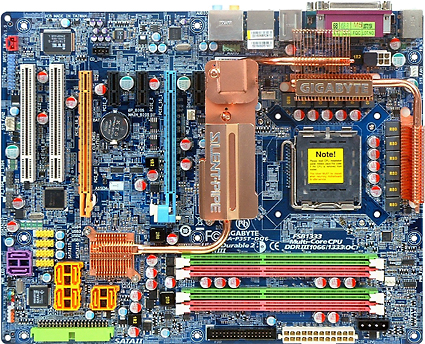DDR3-1333 Speed and Latency Shootout
Test Settings: Overclocking Comparison
DDR3 still hasn't worked its way down to mainstream price levels, and the main reason a buyer would pay relatively-high DDR3 prices is to achieve a similarly-high overclock without "hitting the wall" on memory speed. One could, of course, pay the astronomically high prices of DDR3-1800 or even faster overclock-validated extreme-enthusiast parts, but we wanted to see how far these less-expensive kits would go.
Newer platform components may be available, but the best overclocking motherboards use Intel P35 chipsets while the same company's Core 2 Duo processors withstand much greater bus speeds than its Core 2 Quads. We dug into the parts bin to retrieve the most overclockable parts regardless of age.
| Overclocking System Hardware | |
|---|---|
| Motherboard | Gigabyte GA-P35T-DQ6, Rev. 1.0Intel P35, BIOS F5c (10/26/2007) |
| Socket 775 Processor | Intel Core 2 Duo E6750 "Conroe"(FSB-1333, 65 nm, 2.67 GHz, 4 MB L2 Cache) |
| Hard Drive | Western Digital WD1500ADFD-00NLR1, Firmware: 20.07P20150 GB, 10,000 RPM, 16 MB cache, SATA/150 |
| Graphics Card | Foxconn GeForce 8800GTX, P/N: FV-N88XMAD2-ODNVIDIA GeForce 8800GTX - 768 MB |
| Power Supply | OCZ GameXStream OCZ700GXSSLI - 700W |
| System Software & Drivers | |
| OS | Windows XP Professional 5.10.2600, Service Pack 2 |
| DirectX Version | 9.0c (4.09.0000.0904) |
| Platform Drivers | Intel INF 8.3.1.1009 |
| Graphics Driver | NVIDIA Forceware 163.75 |
Our Intel Core 2 Duo sample is held in high esteem for reaching 520 MHz FSB at its default 8x multiplier and at least 540 MHz FSB using a 6x multiplier on top boards. Using the P35 chipset's highest memory ratio, this allows a 6x CPU multiplier to reach for data rates of 2160 MHz!
Of course, we'd need a motherboard that offered top memory stability, and the most appropriate part we've found for this type of testing is Gigabyte's GA-P35T-DQ6.
In order to reach a variety of memory speeds at a fixed 6x multiplier, we needed to alter the CPU speed for each test. The change in CPU speed has an overwhelming effect on a wide range of benchmarks, so we had to limit ourselves to memory bandwidth benchmarks in the overclocking portion of today's comparison.
| Overclocking Benchmarks | |
|---|---|
| PCMark05 Pro | Version: 1.1.0Memory TestsWindows Media Player 10.00.00.3646Windows Media Encoder 9.00.00.2980 |
| SiSoftware Sandra 2005 | Version 2005.7.10.60Memory Test = Bandwidth Benchmark |
We'll throw a more comprehensive set of benchmarks into our latency tests.
Current page: Test Settings: Overclocking Comparison
Prev Page SPD Timing Comparison Next Page Overclocking ResultsGet Tom's Hardware's best news and in-depth reviews, straight to your inbox.
-
dv8silencer I have a question: on your page 3 where you discuss the memory myth you do some calculations:Reply
"Because cycle time is the inverse of clock speed (1/2 of DDR data rates), the DDR-333 reference clock cycled every six nanoseconds, DDR2-667 every three nanoseconds and DDR3-1333 every 1.5 nanoseconds. Latency is measured in clock cycles, and two 6ns cycles occur in the same time as four 3ns cycles or eight 1.5ns cycles. If you still have your doubts, do the math!"
Based off of the cycle-based latencies of the DDR-333 (CAS 2), DDR2-667 (CAS 4), and DDR3-1333 (CAS8), and their frequences, you come to the conclusion that each of the memory types will retrieve memory in the same amount of time. The higher CAS's are offset by the frequences of the higher technologies so that even though the DDR2 and DDR3 take more cycles, they also go through more cycles per unit time than DDR. How is it then, that DDR2 and DDR3 technologies are "better" and provide more bandwidth if they provide data in the same amount of time? I do not know much about the technical details of how RAM works, and I have always had this question in mind.
Thanks -
Latency = How fast you can get to the "goodies"Reply
Bandwidth = Rate at which you can get the "goodies" -
So, I have OCZ memory I can run stable atReply
7-7-6-24-2t at 1333Mhz or
9-9-9-24-2t at 1600Mhz
This is FSB at 1600Mhz unlinked. Is there a method to calculate the best setting without running hours of benchmarks? -
Sorry dude but you are underestimating the ReapearX modules,Reply
however hard I want to see what temperatures were other modules at
a voltage of ~ 2.1v, does not mean that the platinum series is not performant but I saw a ReapearX which tended easy to 1.9v(EVP)940Mhz, that means nearly a DDR 1900, which is something, but in chapter of stability/temperature in hours of functioning, ReapearX beats them all. -
All SDRAM (including DDR variants) works more or less the same, they are divided in banks, banks are divided in rows, and rows contain the data (as columns).Reply
First you issue a command to open a row (this is your latency), then in a row you can access any data you want at the rate of 1 datum per cycle with latency depending on pipelining.
So for instance if you want to read 1 datum at address 0 it will take your CAS lat + 1 cycle.
So for instance if you want to read 8 datums at address 0 it will take your CAS lat + 8 cycle.
Since CPUs like to fill their cache lines with the next data that will probably be accessed they always read more than what you wanted anyway, so the extra throughput provided by higher clock speed helps.
But if the CPU stalls waiting for RAM it is the latency that matters.

